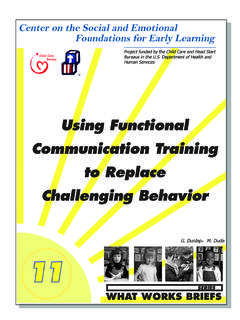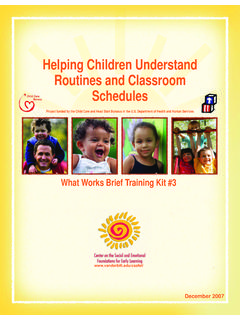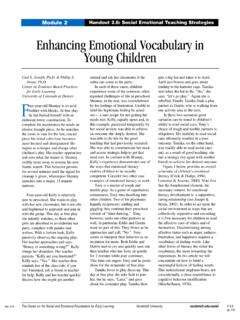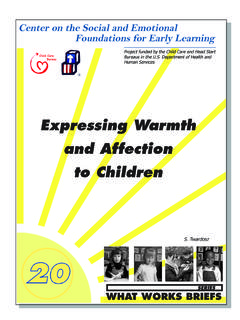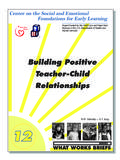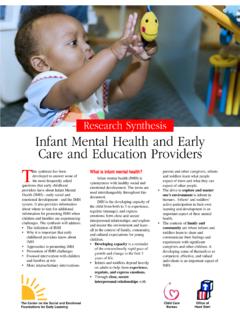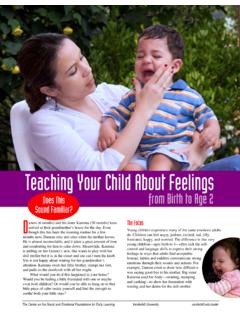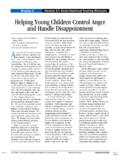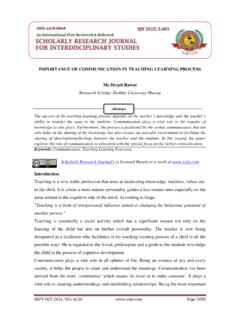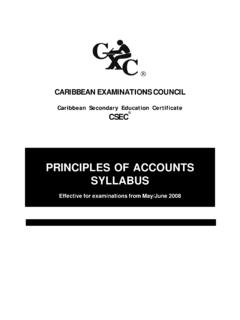Transcription of Understanding the Impact of Language Differences on ...
1 Understanding the Impact of Language Differences on Classroom Behavior Project funded by the Child Care and Head Start Bureaus in the Department of Health and Human Services What Works Brief Training Kit #2. December 2007. The What Works Brief Training Kits were developed to help in-service and pre-ser- vice providers conduct staff development activities. Each Kit is based on one What Work Brief and contains the following items: presenter's PowerPoint note pages, participant handouts, activity ideas, pre-training survey, demographic form, training evaluation, and training certificate. The What Works Brief Training Kits are grounded in the Pyramid model depicted below which provides a framework for describing the four interrelated levels of prac- tice that address the social and emotional development of all children.
2 The Pyramid is designed to guide practitioners in Understanding the importance of children's social emotional competence in terms of school readiness and the prevention of challeng- ing behavior. This What Works Brief Training Kit relates to the High Quality Environ- ments level of the Pyramid. We welcome your feedback as you provide professional development activities with these materials. Special thanks to the Meginnis Endowment at UIUC for funding to help support this effort and to the following individuals who developed the What Works Brief Training Kits materials: Micki Ostrosky, Hedda Meadan, Greg Cheatham, Monique Mills, Sallee Beneke, Nancy Gaumer, Amy Hayden, Elenor Rentschler, and Angel Fettig.
3 Presenter Notes WWB Training Kit #2. Understanding the Impact of Language Differences on Classroom Behavior Presenter PowerPoint Speaker Notes: Presenter should be familiar with the content in What Works Brief #2. and Module 1, Section III on Understanding the Relationship between Challenging Behavior and Social Emotional Development (available at http://. ). Consider using the What Works Brief # 2 handout as a supplemental resource. Welcome participants. Take care of any logistics ( , length of time for session, break, handouts, etc.). Pass out pre-training survey for all participants to complete and turn in, if desired.
4 As you present the workshop: Remind participants to take the culture and background of children into consideration and to work hand-in-hand with parents when they select target behaviors, since some behaviors may be part of the child's culture. Why is Understanding the Impact of Language Differences Challenging for Teachers? Second Language learners and dialect speakers may exhibit social interaction patterns along with limited communication abilities similar to children with disabilities. The time it takes to learn a new Language may vary from child to child depending on age, motivation, knowledge of first Language , personality, and exposure to new Language .
5 Speaker Notes: Increasingly, centers have children who speak languages or dialects at home that are different from what is used for instruction. These children may need additional support to be successful within the center. Greater Understanding by teachers and care providers is important to these children's success. Some behaviors exhibited by second Language learners are similar to those of children with disabilities. Some children acquire a second Language more easily than others. Teachers should be prepared for children's linguistic developmental Differences by Understanding how children learn a second Language and how they can support children who are learning a second Language .
6 Stages in Children's Second Language Learning The continued use of the home Language The silent or nonverbal period Sound experimentation and use of telegraphic speech ( , the use of a few content words as an entire utterance). Productive use of the new Language (Tabors, , 1987). Speaker Notes: 1. The continued use of the home Language Children continue to use their home Language in the classroom even with children and adults who do not speak that Language . 2. The silent or nonverbal period Children become quiet; they speak little of their home Language or English. 3. Sound experimentation and use of telegraphic speech Children begin to use a few content words as an entire utterance ( , saying water rather than Can I have some water?)
7 4. Productive use of the new Language Children know and can produce enough English to interact within the classroom/center. Emphasize that children will go back and forth between these four stages (shown on the PowerPoint slide) as they acquire English. Also, the second Language acquisition process can be frustrating for some children as they work to be understood and to understand others. Discussion Question What challenging behaviors might an English Language learner exhibit? Speaker Notes: Discussion Question: What challenging behaviors might an English Language learner exhibit? Suggested Responses: Not talking Difficulty following directions Difficulty expressing ideas and feelings Difficulty responding to questions consistently Pretending to understand English Biting, hitting Socializing only with children who speak the same home Language Activity 1.
8 Pair-Think-Share Pair with a partner Read the scenario Think about the child in the scenario Share your thoughts Speaker Notes: Assign partners. Have each pair read the scenario about Janelle on the next slide (or on handout). Pairs should think about 1. To what extent do you think Janelle's behavioral difficulties are due to Language Differences ? Why do you believe this? Have you seen children in this situation? 2. What supports might help Janelle? Share thoughts with the larger group. Janelle Janelle is a new student in Ms. Corinne's classroom. She is extremely shy, generally quiet, and seems to like to keep to herself.
9 When asked to participate in an activity, Janelle often refuses- especially when it involves large groups of children. She vigorously shakes her head in response to anything Ms. Corinne asks her to do. Lately, she has resorted to crying and throwing temper tantrums, especially when forced to join the group. To reduce the stress on Janelle and the other children, Ms. Corinne lets Janelle out of the activity to allow her to calm down. Ms. Corinne tries to explain to Janelle what she has to do, but Janelle often looks at her teacher blankly and does not respond to Ms. Corinne's questions or follow her directions. Ms.
10 Corinne is becoming more and more frustrated as the weeks progress. Speaker Notes: Pairs should think about 1. To what extent do you think Janelle's behavioral difficulties are due to Language Differences ? Why do you believe this? Have you seen children in this situation? 2. What supports might help Janelle? Share thoughts with the larger group. Getting to Know English Language Learners Look closely at a child's strengths and needs when developing curricular ideas. Investigate the following: The child's abilities (cognitive, social emotional, and physical development). The child's abilities in the first Language The child's capabilities in the second Language (English).
